Soviet fighter-bomber aircraft
With the liquidation of N.S. Khrushchev assault aviation as a class, decommissioning the existing IL-10M piston for scrap and rejecting the release, which has no analogues of the IL-40 jet attack aircraft, this niche was occupied by the MiG-15 and MiG-17 fighter jets. These aircraft had a fairly powerful cannon armament and good visibility from the cockpit, but did not meet the requirements of the Air Force in terms of flight speed and mass of the missile and bomb load.
The Su-7 supersonic front-line fighter, later converted into the Su-7B fighter-bomber, despite the increased characteristics, also did not fully satisfy the military. At the same time, its combat load, taking into account the new assignment, increased four times and reached 2000kg.
The specified specialization of the aircraft, as the results of the tests and operating experience were generalized, determined the direction for further continuous improvement, which lasted until the start of the 1970's. In total, with 1957 - 1972, 1874 aircraft modifications were built at the Komsomolsk-on-Amur plant:
-Su-7BKL (product "С22КL") - wheeled-ski modification of the aircraft, to improve the conditions of basing on unpaved runways (1965-71).
-Su-7BM (product "С22М") - modification of the Su-7B with the new on-board equipment and the AL-7F-1 engine with an increased resource (1962-64).
-Su-7BMK (product "С22МК") is an export version of the SU-7BM, with some design improvements implemented on the Su-7BL; The latest series of aircraft were equipped with an additional pair of suspensions (1966-71).
-Su-7U (product "У22") - training and modification of the aircraft based on the SU-7B (1965-71).
-Su-7UMK (product "U22МК") - export version of the Su-7U (1965-71).
An increase in the combat effectiveness of the vehicle was accompanied by an increase in its take-off mass and a deterioration in the take-off and landing characteristics. The beginning of the operation of the Su-7B units had years to come, when the adoption of tactical nuclear weapons weapons exacerbated the problem of the vulnerability of airfields front-line aviation. The solution of this task was seen in the dispersal of front-line aviation during the period of danger and the related requirement of ensuring combat operations with the runway of limited size. This task could be solved by the use of lifting engines, or the system of variable sweep of the wing.
In May, the 1965-th Design Bureau together with TsAGI began to develop the C-22I or Su-7IG aircraft (variable geometry). The experimental machine turned only the outer parts of the wing, located behind the main landing gear.
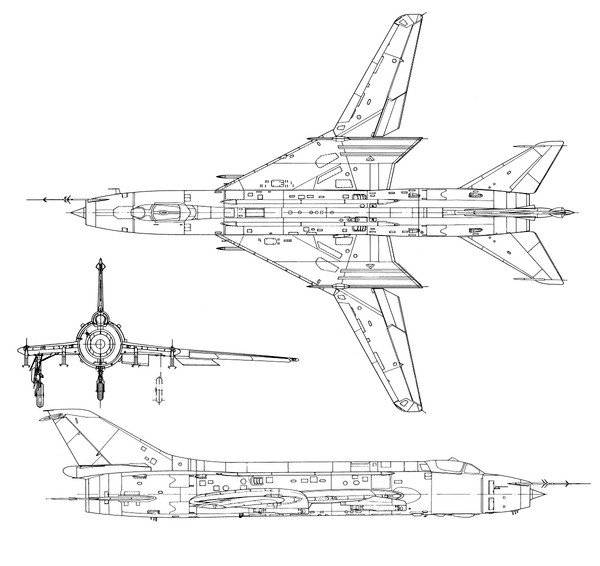
Such a layout improved the take-off and landing characteristics and increased the aerodynamic quality on the dial. The choice of Su-7B as a prototype for the experimental machine was justified. This supersonic fighter-bomber was produced in large series, a relatively inexpensive modernization turned it into a multi-mode aircraft.
The wing was structurally divided into fixed, docked to the fuselage and moving parts (PTS) with a single profile, providing a continuous flow around the root part, which favorably influenced the work of the tail fin. The wing span at maximum sweep increased by 0,705 m, and its area - by 0,45 м2. The combination of three-slats on the swivel consoles with flaps throughout the scope significantly improved takeoff and landing characteristics. But it had to be paid for by decreasing the capacity of wing fuel tanks-caissons on the 440 l, increasing the wing mass by 400 kg due to the turning mechanism (hinges, hydromechanical drive, synchronizing shaft and hydraulic system elements) and complicating the wing design.
The result of the successful completion of tests of the C-22I was the output in November of the 1967 government decree on the development of the Su-17 fighter-bomber with variable wing geometry and its launch into mass production at the Far Eastern Machine-Building Plant in Komsomolsk-on-Amur.
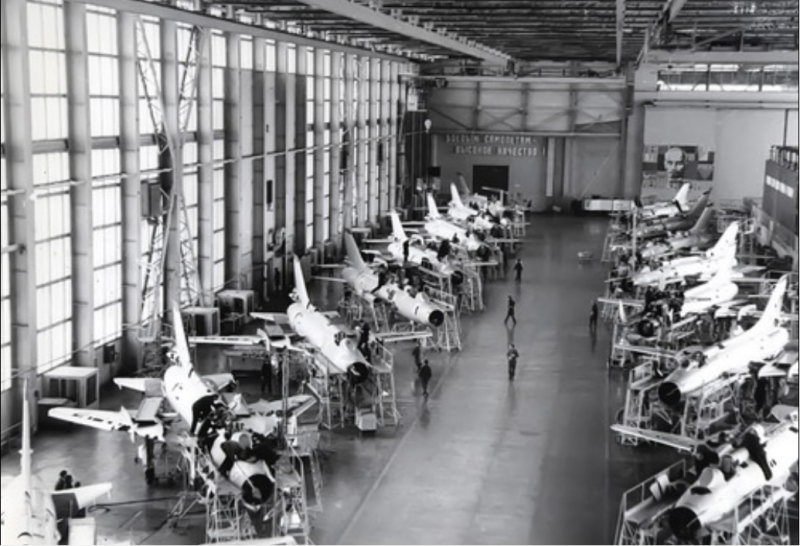
In October, the 523 th Red Banner iap of the Far Eastern Military District was the first to begin the development of the Su-17, this official name was assigned to the serial C-32.

The aircraft was in serial production from 1969 to 1990 year, during which time 2867 fighters were built - the bombers of the following modifications:
-Su-17 first serial version, up to 1972, released a few dozen.
-Su-17М modification with TRDF AL-21Ф3, increased fuel capacity, more advanced avionics, extended nomenclature of weapons and some other changes; produced with 1972 g .;
-Su-17М2 version with an elongated 200 mm nose fuselage, new avionics and an extended range of guided weapons; made the first sortie at the beginning of 1974, mass production was carried out in 1975-79;
- Su-17M3 further development of M2; installed new sighting equipment, increased fuel stock; produced with 1976 g .;
Su-17М4 version with a new avionics, unregulated air intake and some design changes in the fuselage; the prototype appeared in 1980, mass production was carried out in 1981-90;
-Su-XNUMHUM double combat-training aircraft, equipped with avionics, used on the Su-17М17; the prototype appeared in 2 g., serial production was carried out in 1975-1976 gg .; the design of the aircraft served as the basis for the creation of the Su-78М17;
-Su-17UM3 two-seater combat training aircraft equipped with avionics used on the Su-17М3; produced with 1978 g .;
-Su-20 export version of the Su-17M with a simplified avionics and a shortened nomenclature of weapons; released in 1972 g .;
-Su-22 export version of the Su-17М2, equipped with the TRDF P-29BS-300, which was later installed on aircraft of other export modifications; produced with 1976 g .;
- Su-22М export version of the Su-17М3; released in 1977 g .;
- Su-22М3 export version of the Su-17М3 with more advanced, compared with the Su-22, avionics; produced with 1982 g .;
- Su-22М4 export version Su-17М4; engine AL-21Ф3; produced with 1984 g .;
- Su-22UM export version of the Su-17UM; produced with 1976 g .;
- Su-22UM3 export version Su-17UM3; release was carried out with 1982 .;
-Su-22UM3K combat training option Su-22М4, also intended for export deliveries; produced with 1983
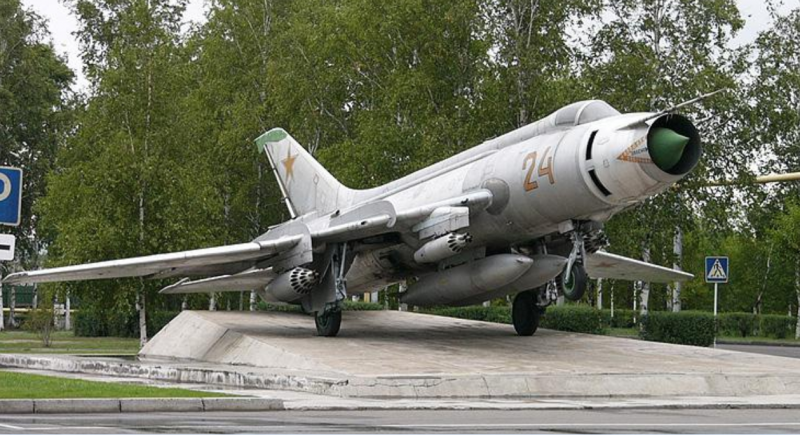
The latest version of the Su-17, introduced into mass production, was the Su-17М4. Its development has been conducted in the Sukhoi Design Bureau since March 1977.
The first prototype appeared on the airfield in 1980, and in the same year, three prototypes presented for state tests, successfully completed in November, 1982.
On the plane installed ejection seat K-36DM. Taking into account the main purpose of the vehicle - the attack of ground targets, they abandoned the regulated air intake, fixing the cone in the optimum position for transonic low-altitude flight. The maximum speed at height was limited to the value corresponding to the number M = 1,75.
Externally, the C-17М4 differed from the Su-17М3 by a small air intake on the gargrot in front of the keel, but in terms of the "stuffing" it was a completely different car. At Su-17М3, the joint operation of various on-board systems was provided by the pilot. During the tests of the aircraft with an ASP-17B sight with an analog-digital computer, the need to include an onboard computer onboard computer was revealed. For C-54 developed PNK-54 based on the on-board computer "Orbita-20-22", SAU-22М2, SUO-54. The use of guided weapons with semi-active laser guidance was provided by the Klen-PS laser rangefinder-target designator, and with the television indicator IT-23М. On the C-54 during the launch of the UR, the overlap of the center mark of the sight on the target was made by the joystick, and not by maneuvering the aircraft, as on the Su-17М3, which had the mark moved by the joystick after the missile went off the track.
The armament consisted of X-25ML missiles, and the KAB-500Kp corrected aerial bombs, which require large angles of pumping of the laser beam to highlight the target due to the significant lagging of the bomb from the plane at the time of the fall, were replaced with KAB-500T from the television GOS. The lack of automatic target tracking required such a choice of the dynamic characteristics of the target — pilot-operator — Klen-PS station so that the manual correction of the Klen-PS sight line provided the necessary precision of the X-25ML guidance. This task was brilliantly solved, and X-25ML has not lost its effectiveness. Included in the armament of the aircraft and the X-29T rocket. State tests were successfully completed in November 1982-th, under the designation Su-17М4 the aircraft adopted the 1983-th in September. The same order was adopted by the Su-17UM3.
To solve reconnaissance tasks, a part of the aircraft, designated Su-17М4-Р (Su-17М3-Р), was equipped with KKR-1 / 54 suspension containers for conducting integrated reconnaissance (radio, photo, IR and television).
Almost simultaneously with the appearance of the Su-17, on the basis of a front-line fighter with a variable geometry wing MiG-23, its percussion version MiG-23B was developed and launched into the series.
The creation of the aircraft was officially confirmed by a Resolution of the Central Committee of the CPSU and the USSR Council of Ministers on February 4 of 1970 of the year.
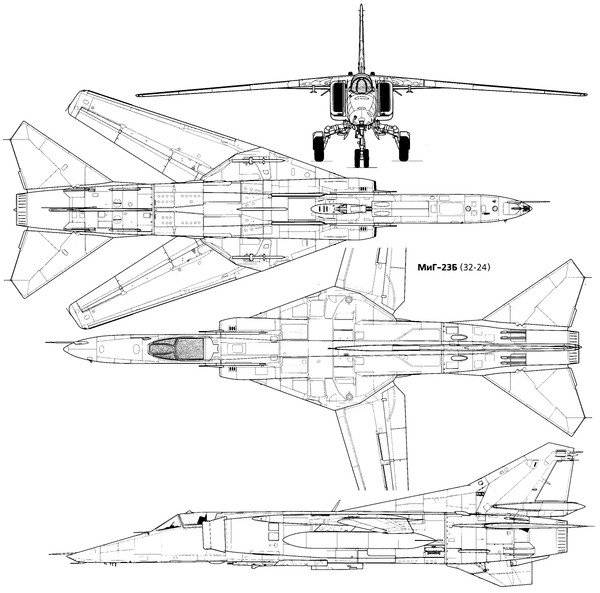
The characteristic outline of the bow was determined by the conditions of the sight ASP-17. The automatic rifle scope was developed at the Leningrad enterprise "Arsenal" for promising attack aircraft and provided accurate aiming bombing, the launch of the NAR and firing from level flight and diving. During the sighting of the target, his movable aiming mark could deviate downward at an angle to degrees, projecting onto the glass-reflector of the sight. So that the nose of the aircraft did not obscure the target, its contours were determined by the corresponding angle, which formed the generator of the upper part of the nose, sloping down directly from the canopy of the lantern and the viewing sector from the cabin was just degrees. The layout was not only successful, but also expressive, literally emphasizing the purpose of the aircraft.
The fighter-bomber acquired an unusually functional and impressive predatory appearance that became characteristic of all subsequent modifications, at the same time securing the popular nickname “Crocodile Gena”.
In addition to the absence of a radar that was beveled for a better forward-down view of the nose and the installation of special target equipment, according to the airframe, the aircraft differed little from the MiG-23С fighter, which had been in serial production since the beginning of 1970.
In 1973, the MiG-23BN appeared with the more economical P29B-300 engine. Despite the fact that the MiG-23BN remained in production until the 1985 year (for export deliveries), it was an interim solution, which did not satisfy both the creators and the customer. The military made demands to increase the combat effectiveness of the aircraft, which was inferior to the Su-17, which was similar in purpose, in terms of combat load and range of weapons, as well as a number of flight performance, including takeoff and landing qualities and ease of piloting. The machine needed a qualitative improvement, especially since the designers had a number of thoughtful suggestions for the modernization. The set of measures to improve the shock MiG proposed upgrading in three directions: constructive improvements of the aircraft, the introduction of new target equipment and the strengthening of weapons. The radical way with the simultaneous introduction of innovations to most of the systems and units contradicted the usual practice of gradual improvement of the machine according to the principle “no more than one serious innovation in the next modification” (a rule tested by time). More than once it happened that the technical risk of a multitude of still “raw” new products infinitely tightened.
The new aircraft received the name of the MiG-23BM. On it for the sake of increasing the weight of the combat load, the maximum speed and ceiling were somewhat reduced. Adjustable air intakes, inherited by the MiG-23B from the twenty-third destructive versions, were replaced with lightweight unregulated ones by the MiG-23BM. Simplifying the design with the rejection of the adjustable wedge and its control system saved about 300 kg. The aiming system based on the analog computer by this time did not have sufficient efficiency, did not provide the proper accuracy characteristics, and demanded that the pilot had excess voltage in flight when performing many operations. The bet was made on a new high-performance electronics complex that gave the car being created significant advantages.
Armament aircraft has undergone a number of innovations. First of all, the artillery weapons were replaced by more powerful ones. The power and impact of the 23-mm projectiles of the GSH-23L cannon, which for many years served on most combat aircraft, was not enough for the confident destruction of many ground targets, especially armored vehicles. The armies of the NATO countries received new armored vehicles, to combat which the armor penetration capability of 23 mm caliber shells was already weak. In this regard, it was decided to install a new 30 mm caliber multi-cannon on the aircraft, ensuring a high rate of fire and a large weight of a second salvo.
The art system GSH-6-30А possessed impressive characteristics, demonstrating absolute superiority over the majority of western designs.
Production of the MiG-23BM promptly established at the end of the year 1973. To a large extent, this was facilitated by the good mastering of technological processes and decisions in production and the continuity of the structure, since it had a lot in common with "spark".
The series continued until the spring of the 1978 of the year and the 360 MiG-23BM was manufactured in total, which, after conducting the entire test program, was put into service in February of the 1975 of the year under the MiG-27, although the aircraft was often called for the same name in operation and production.
In parallel with the MiG-23BM, the development of two more modifications, differing more advanced sighting equipment. The level of new technologies achieved in the country, microelectronics, and optoelectronic equipment made it possible to develop workable equipment for the sighting system, the analogue of which the potential enemy did not have. The name of the complex "Kaira" was chosen with the meaning: the kaira is different in that this bird's eyes can look in different directions and even "in the tail" during the flight (as well as the optics of the "Kaira" aircraft, capable of "filling up" the direction of sight and laser ray back on the flight).
Guided weapons, for which, in principle, this modification of the aircraft was created (and many types of ammunition, in turn, themselves were developed "under the plane"), also significantly increased and increased. The first was KAB-500L, with its own weight in 534 kg it had a powerful penetrating high-explosive warhead weighing 360 kg and was intended to defeat protected and very strong stationary targets - shelters, gearboxes, bridges, warehouses and other things. Targeting a bomb on the target was carried out on the reflected radiation using a laser targeting system. A receiving device with a photodetector and a moving focusing coordinator tracked the target with the laser radiation reflected from it, and the control unit aimed a bomb at it. Target capture range -3,5-6 km with a meteorological range of visibility 10 km. During the tests, a circular deviation of 8-10 meters was achieved. With 1975, KAB-500L began to enter service.
Later, the new Kab-500 bombs, equipped with a television-correlation seeker, were replenished with an arsenal of vehicles. Bombs could be dropped singly and in a volley from level flight, diving or pitching in daytime conditions (for illuminated targets - and at night), including for several separated targets in one attack.
The combat effectiveness of the MiG-27K has increased many times over the predecessor. So, to complete the task, which required seven MiG-27, only four Kayr were enough.
However, given the complexity and high cost of Kaira, there was a need for such a modification of the aircraft, which, with new equipment and weapons, would have surpassed the MiG-27 in its fighting qualities, but would have been cheaper than the MiG-27K, even to the detriment of some capabilities. The MiG-27M took over practically the entire arsenal of bomb and missile weapons from the MiG-27K, with the exception of adjustable bombs from a semi-active laser seeker (Klen-PM could not throw the beam back). Tests and operation of the new machine showed that the MiG-27М in its capabilities significantly exceeds the MiG-27 and is not inferior in many respects to Kayre.
In 1990, the USSR Air Force had 535 Su-17 and 500 MiG-27, most of them went to Russia. At that time, in their main part they were fairly modern combat vehicles. However, the leadership of the “new Russia”, in spite of the very effective use of Su-17М4 in the First Chechen, considered the presence of fighter-bomber aviation in the structure of the Air Force unnecessary. A significant part of the aircraft of the liquidated parts was immediately sent to scrap, the rest were sent to "storage".
The bet was made on the Su-24 front-line bombers and Su-25 attack aircraft. If necessary, the MiG-29 and Su-27 fighters should have been used for strikes (especially the "wise" option is to re-equip the latter with NURS units). However, further events showed the fallacy of such a decision. Su-24 bombers, intended for the destruction of particularly important targets, in the operational rear of the enemy, proved to be too expensive and difficult to operate for use in the "counter-terrorist operation", and Su-25 had limited capabilities to use guided weapons and a small radius of action.
During the Second Chechen, an attempt was made to return Su-17М4 to the Air Force, but it turned out to be impossible in practice. For several years, the planes that are “in storage” in the open air have come to a completely non-flying state, their equipment has been dismantled and plundered.
Nevertheless, some of the Su-17, which remained in the flying state, still continue to rise into the air, mainly the “Sparky” used for training flights.
Based on:
http://www.airforce.ru/content/sovremennyi-period/260-vzglyad-na-razvitie-vvs-sssr-80-h-90-h-godov/
http://www.airbase.ru/hangar/russia/mikoyan/mig/23/b/
http://worldweapon.ru/sam/su17.php
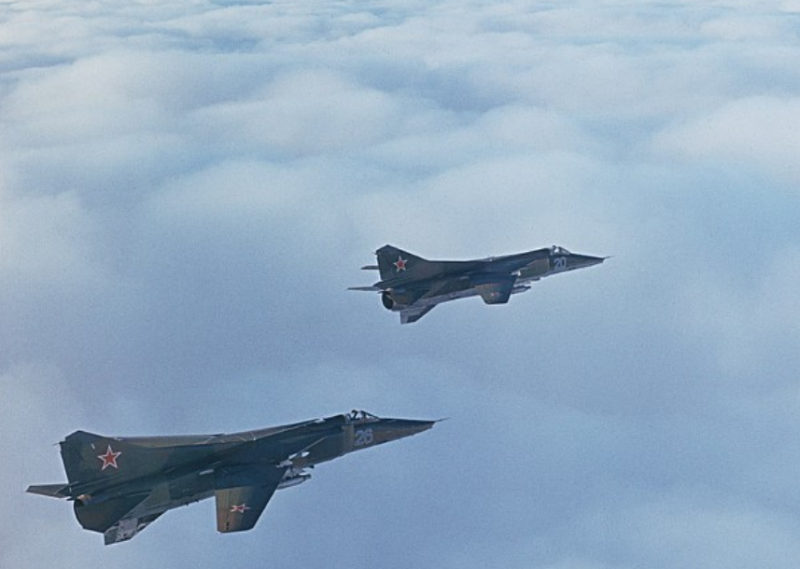
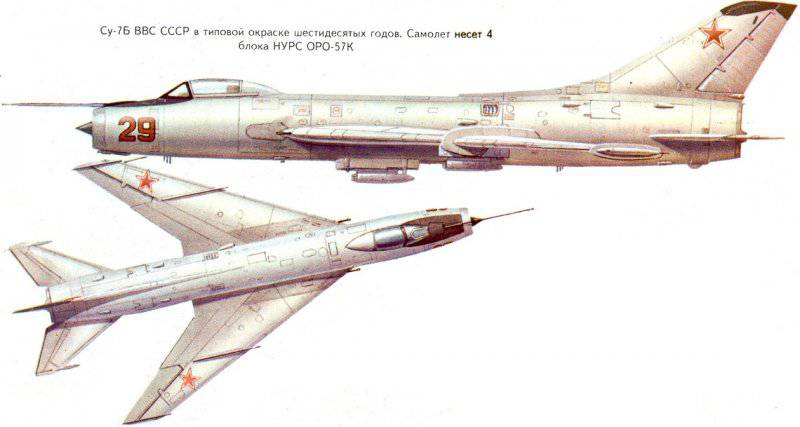
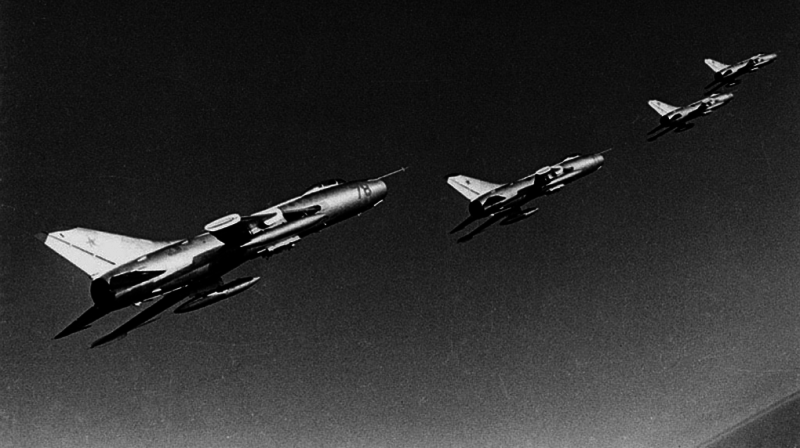
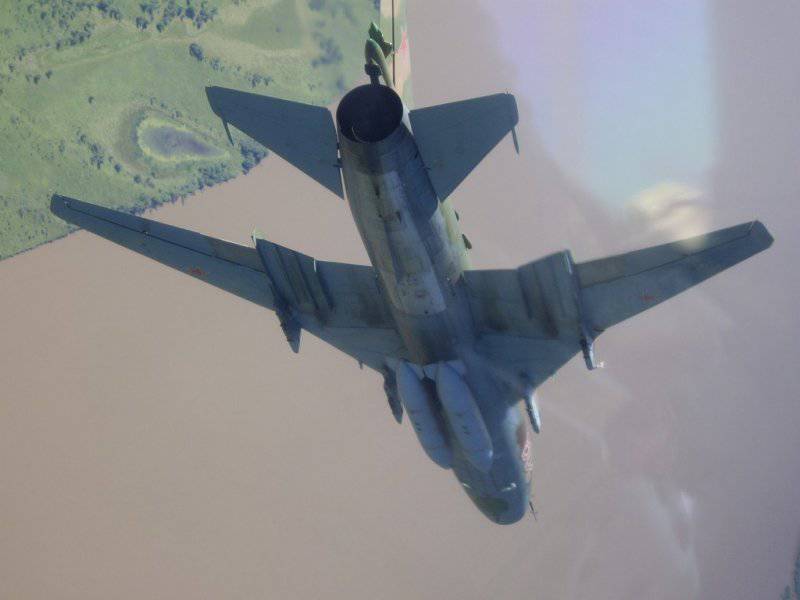

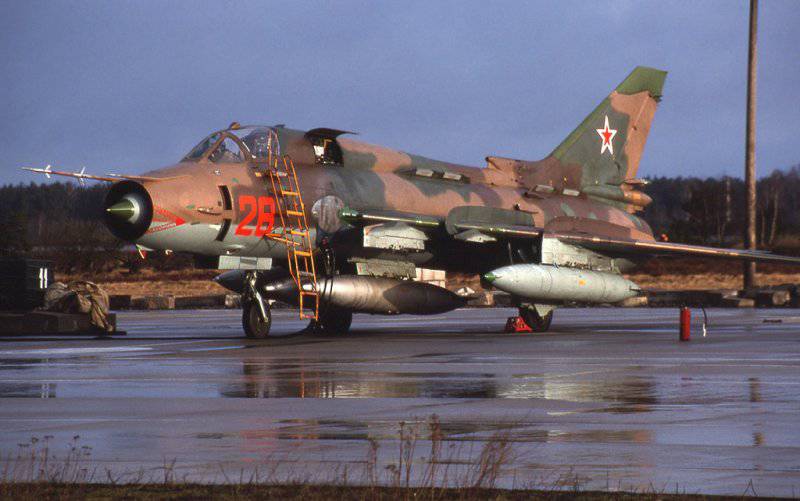

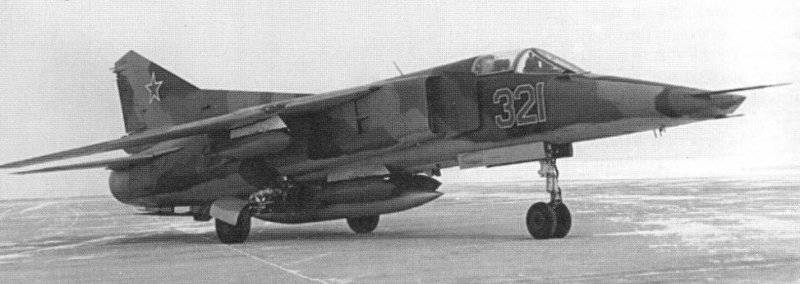

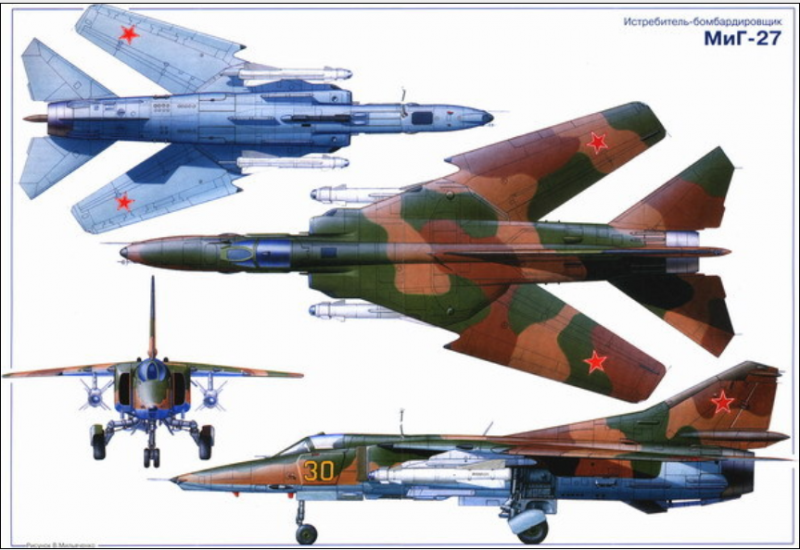
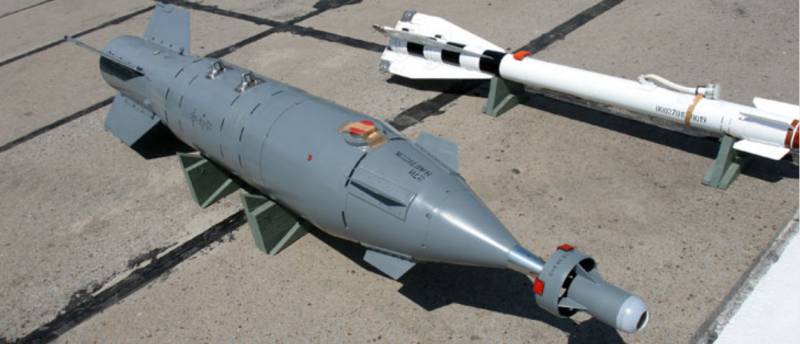
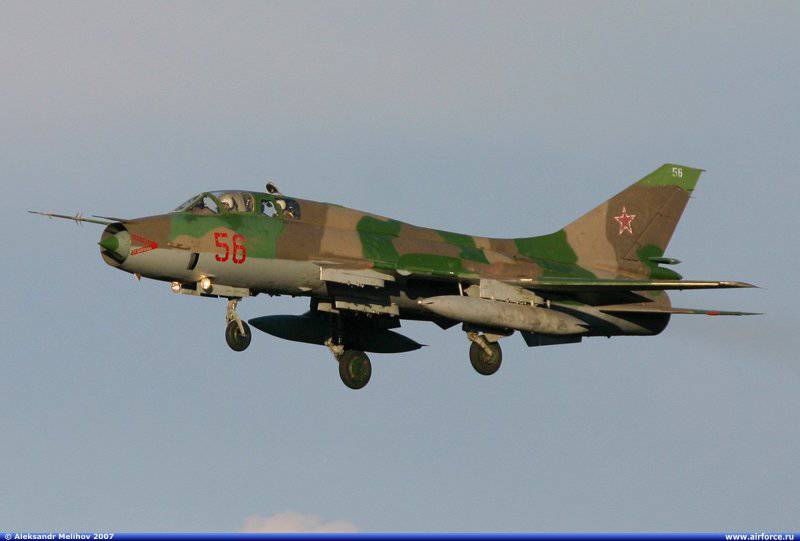
Information